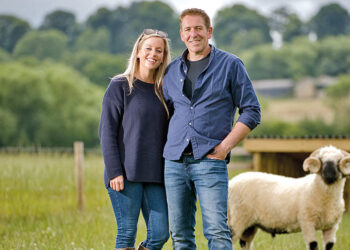How surprised was science when bird flu was detected in dairy cattle with those warnings against raw milk or eating unpasteurized dairy products?
Two Auburn University researchers are offering their expertise on the topic. Dr. Shollie Falkenberg, an associate professor and coordinator of animal health research, and Dr. Cris Young, a professor of practice at Auburn’s College of Veterinary Medicine, provide the following informed, broad perspective on the issue.
The expertise and opinions of individual faculty members do not necessarily represent an official policy or position of Auburn University. Still, two of its top searchers are sharing their knowledge on the recent discovery of avian flu in dairy cattle.
So, was it surprising that avian flu was recently found in dairy cattle? And If so, why?
Professor Young: Yes, it wasn’t on our radar. We consider this an emerging disease event in cattle. While HPAI is reportable in poultry, the current regulatory environment does not similarly categorize Influenza A (IAV) in cattle. That is to say, no regulations exist for testing or movement controls. That is why the federal order was the first action taken.
Associate Professor Falkenberg: Yes and no. Yes, it was surprising as this was not being monitored and was thought to be a significant threat to the cattle industry, but no, given the number of other mammals that have been shown to become infected with HPAI. Furthermore, in the 1990s, a correlation between influenza A virus infection, reduced milk yield, and respiratory symptoms in dairy cows has previously been reported. However, HPAI infection has not been reported until recently in dairy cattle. Other reports of cattle infected with influenza A virus have also been documented. Given that influenza viruses are negative-sense single-stranded viruses prone to reassortment and spillover, it is not beyond the scope that it would be possible for cattle to become infected with HPAI. It is more generally accepted and thought that cattle become infected with influenza D, not A.
Should people be worried about contracting avian flu from food?
Young: People should always handle food safely regardless of source. If you develop good food preparation habits and techniques, they will serve you well.
Falkenberg: Proper food handling should always be practiced.
Can you explain the term “highly pathogenic avian flu” (HPAI)?
Young: HPAI means that the IAV is a highly contagious, multi-organ systemic disease of poultry that leads to high mortality in poultry.
Falkenberg: HPAI is a highly contagious disease often associated with increased mortality in poultry. It is generally caused by influenza A (H5 and sometimes H7) viruses. It should be noted that the “highly pathogenic” refers to the impact these viruses have on birds, not necessarily on humans and other mammals that have been shown to become infected.
Should we be worried about cows transmitting bird flu to humans?
Young: We should. HPAI has the opportunity to mix with other human-adapted IAV strains, potentially allowing HPAI to incorporate genetic material from the human IAV strain. This could potentially lead to a strain that circulates in people and possibly a pandemic.
Falkenberg: As with any pathogen and morbid animal, proper biosecurity and risk assessment of transmission to humans and other animals should be considered. Additionally, given that individuals handling infected birds have become infected, it would be assumed that if one species can transmit the virus, another species would also have that potential.
Do we know how bird flu is affecting dairy cattle?
Young: The virus appears to be affecting lactating dairy cattle. Milk production is reduced, some milk is thickened in appearance, and some cattle are mildly ill.
Falkenberg: It appears that older cows in mid to late lactation are most affected. The clinical presentation was associated with reduced feed intake, decreased milk production, and thickened yellow milk. This peaked four to six days after onset and subsided within 10 to 14 days.
With bird flu having spread recently to dairy cattle, can it be transmitted through milk?
Young: Yes, through raw, unpasteurized milk, but not through the milk or dairy products you would buy at the grocery store. Pasteurization is an essential food safety process.
Falkenberg: It would be assumed that there would be an increased risk of transmission with unpasteurized (raw) milk.
How does the pasteurization process of milk work, and why is it so vital?
Young: The most common method of pasteurization is High-Temperature Short Time (HTST) pasteurization, where milk passes between metal plates, and hot water is used to raise the temperature of the milk to 161 degrees Fahrenheit for not less than 15 seconds, followed by rapid cooling.
Falkenberg: The most common method of pasteurization typically utilizes high temperature. To follow up and give some perspective on the previous question, influenza viruses have been reported to be inactivated (non-infectious) at the following temperatures: Viral genomic RNA becomes denatured at temperatures higher than 60 degrees Celsius. Immunoglobin denatures at temperatures higher than 56 degrees Celsius. On the other hand, pasteurization temperatures are typically greater than 100 degrees Celsius.
What are the symptoms of bird flu, and what should someone do if they suspect they might have been exposed to it?
Young: Very few, if any, individuals should worry about “bird flu” at this time. However, if you work around poultry, live birds, or processing, you should consider influenza if you have a fever, chills, cough, runny or stuffy nose, headaches, fatigue, or body aches.
Falkenberg: Generally, people should not be overly concerned about being exposed to “bird flu” now. However, people who work around poultry, live birds, or processing may be at greater risk and should seek medical advice if they suspect an exposure or if they have a fever, chills, cough, runny or stuffy nose, headaches, fatigue, or body aches.
How is Auburn helping address the disease-causing strain of avian flu, known as H5N1?
Young: Auburn has many phenomenal researchers, and at the College of Veterinary Medicine, our virologists like Dr. Miria Criado, Dr. Falkenberg, and Dr. Constantinos Kyriakis are leading cutting-edge programs.
I believe the BISR project has game-changing potential:
Falkenberg: Auburn continues to monitor the information released from the current outbreak and is communicating with government agencies and other researchers to assist as needed. Auburn has a solid group of scientists who have ongoing research programs focusing on influenza and are involved in ongoing discussions about research needs to address the current concerns.
(To sign up for a free subscription to Food Safety News, click here)













